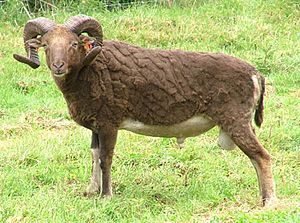Castlemilk Moorit facts for kids

A Castlemilk Moorit ram after shearing
|
|
| Conservation status | The Castlemilk Moorit is a very rare breed. The FAO listed it as endangered in 2007. The RBST listed it as Category 4 (vulnerable) in 2017. |
|---|---|
| Country of origin | Scotland |
| Use | Hobby farming |
| Traits | |
| Wool color | Tan, brown, reddish-brown |
| Face color | Brown |
| Horn status | Horned |
|
|
The Castlemilk Moorit is a special and rare type of domestic sheep. It is also sometimes called the Moorit Shetland, Milledge Sheep, or Castlemilk Shetland. This unique sheep breed comes from Dumfriesshire in Scotland.
Contents
About the Castlemilk Moorit Sheep
Where Do They Come From?
The Castlemilk Moorit sheep was first created in the 1900s. It was bred to be a beautiful animal to live in the parkland of Sir John Buchanan Jardine's estate. It is a mix of a few older, wilder sheep types. These include the Manx Loaghtan, the Shetland, and the wild mouflon.
The breed's name comes from the Castlemilk Estate where they were first bred. The word "moorit" comes from the Scots language. It describes the light tan or reddish-brown color of their wool.
What Do They Look Like?
The Castlemilk Moorit is part of a group called Northern European short-tailed sheep. This means they have a short, triangular tail. Both male and female Castlemilk Moorits have horns. Their wool is usually shed naturally, or rooed (plucked), instead of needing to be shorn. This makes them quite unique!
Why Are They Rare?
All Castlemilk Moorits alive today come from just one small group. This group had only ten female sheep (ewes) and two male sheep (rams). Because of this, the breed is very rare.
The British Rare Breeds Survival Trust lists this breed as "vulnerable." This means there are not many of them left, and they need protection. There are fewer than 900 registered Castlemilk Moorit sheep. Luckily, there are important groups of Castlemilk Moorits in the Netherlands and Belgium. These groups help make sure the breed will continue to exist in the future. These sheep are mostly kept by people who enjoy them as a hobby.

